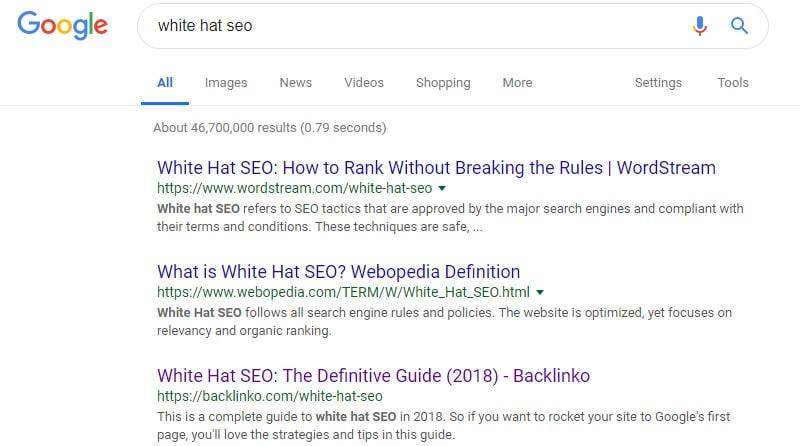Table of Contents
- Why You Can Trust This Guide
- The SEO Challenges and Goal of a Website
- Defining White Hat SEO
- Google Rankings
- Quality of Content, Backlinks and KPIs
- Researching and Vetting Content Ideas
- The Anatomy of Successful Content
- Backlinks: Assume You Need Them. Always.
- The Backlink Challenge: Acquisition
- The Backlink Acquisition Solution: Content Promotion
- Sustainability: Grow and Engage Your Audience
- Putting all the pieces together
- Why You Can Trust This Guide
- The SEO Challenges and Goal of a Website
- Defining White Hat SEO
- Google Rankings
- Quality of Content, Backlinks and KPIs
- Researching and Vetting Content Ideas
- The Anatomy of Successful Content
- Backlinks: Assume You Need Them. Always.
- The Backlink Challenge: Acquisition
- The Backlink Acquisition Solution: Content Promotion
- Sustainability: Grow and Engage Your Audience
- Putting all the pieces together
With the right combination of white hat SEO tools, authoritative backlinks, quality writing, and content promotion, you can dominate your SEO competition!

Why You Can Trust This Guide
This guide is a combination of our extensive experience as an agency, aggregated data from some incredible tools and sources, and advice from industry experts. It began long ago as an internal process document, and slowly evolved into something we were proud to share with our clients and the public.
You will notice that we refer to tools from Ahrefs (ahrefs.com) frequently. Yes, we do utilize Ahrefs’ paid tools internally as an agency and use them to great effect for our SEO clients. However, we have no incentive from Ahrefs to promote their products here. We, like thousands of other agencies and even direct Ahrefs competitors, just recommend certain tools within their suite because they are simply the best available and in many cases have no equal.
The SEO Challenges and Goal of a Website
At its core, a business’ website is a customer acquisition channel that converts visitors into customers and makes money. In order to gain visitors, a website must be promoted or found via organic searches with engines like Google. The purpose of this article is to show you how to succeed at the latter: organic rankings with Google. The common term for this is SEO, or Search Engine Optimization.

A website has two primary SEO challenges to overcome to gain significant organic traffic:
- A website’s content must be high-quality: extremely well written, useful, relevant and unique.
- A website needs a strong, high-quality backlink profile to help prove the relevance of its content to Google.
To overcome the above two SEO challenges, a website must develop itself as a resource of high-quality and extremely useful content that is well-linked to by other authoritative domains in order to prove to Google your content is relevant and worthy of consumption, and therefore rank well in organic search results. To rank well with Google, you must write high-quality content and get high-quality backlinks to your content.
This is not easy, however. Researching trafficked keywords you can realistically rank for and creating useful and unique content that is also well-written are both extremely time-consuming. And no matter how good your content is, quality backlinks won’t happen naturally at first either. You’ll need both a large audience as well as an advertising budget to gain traffic and build links, both of which pose their own obstacles.

Fret not though! This is why you come in armed with powerful SEO tools and proven techniques so you can crush these obstacles! This guide builds on the data from powerful tools and the knowledge of industry experts, and addresses these challenges and how to overcome them.
If you glean nothing else from this guide, remember this fact: backlinks are the MOST important factor in determining Google rankings. Yet obtaining them properly is difficult and time-consuming. You will see this fact repeated throughout this guide, as it is crucial to keep in mind. Nothing correlates stronger with Google ranking than a site’s backlink profile. And don’t worry, we will prove this premise later in this article.
Defining White Hat SEO
As you probably know, SEO (Search Engine Optimization) refers to optimizing a website or web page to rank well in organic (unpaid) search results. As an SEO marketing agency, we focus on Google’s preferences due to their immense market domination. However, the techniques detailed in this article should prove just as effective for the other major engines.
Google determines the rank of websites automatically through complex and top-secret algorithms. Overtime, people and SEO companies have learned to exploit these ever-adapting algorithms through techniques that have proven to work well to improve rank, but in ways which Google never intended to be done. In fact, the search giant has told the public time and time again that exploiting their algorithms can lead to deindexing and blacklisting of your pages and/or domain. Although such “black hat” and “gray hat” techniques are waning in effectiveness, they still can work – until Google catches you.
We’ve seen it happen. A client’s competitor has nearly-unbeatable SEO, until one day they just fall off the face of the SEO earth. What happened? Google wised up and put the pieces together. They were manipulating Google’s algorithms, and paid the price. It is only a matter of time before Google’s algorithms become so intelligent that black and gray hat SEO techniques become completely obsolete. Money put into these methods will have decaying results as well, as they are more and more easily discovered and disregarded by Google.

All of this is detailed to explain why we take the high road at Jack & Bean and only focus on true White Hat SEO – as you should as well. White Hat SEO is the optimization and promotion of a website in moral, natural and Google-approved methods for the purpose of ranking well with Google. White Hat SEO is the only sustainable method moving forward in our professional opinion, and if you don’t believe us, just check out the opinions of these SEO giants: Backlinko & Ahrefs. But first let’s back up a bit and lay some groundwork regarding Google and its search engine.
Google Rankings
As of 2018, Google has over 90% market share for search engines. 9/10 people use Google to search the internet. Thus, you can expect most of your organic traffic to come from Google.com. Being “top of page one” for target keywords and key phrases on Google is a no-brainer to gaining necessary target traffic and should be the obvious goal of any website or blog. The first search result position gets nearly ⅓ of all organic search clicks, and the top three positions on Google get over half of all clicks, in a 30/15/10% split for 1st/2nd/3rd, respectively. This is the kind of traffic you want: organic, sustainable, relevant.
The Enigma of Google’s Algorithms
Technically, nobody knows exactly how Google determines its algorithms – except Google, of course. It’s a closely guarded secret worth countless trillions. Their algorithms also change constantly and they roll out large updates periodically. However, in a Q&A session in 2016, Google’s Andrey Lipattsev revealed the two most important Google ranking factors, “I can tell you what they are. It is content. And it’s links pointing to your site.” He wouldn’t explicitly say which one was more important – content or backlinks – and honestly it technically can depend. Building on those pillars though, we can deduce which one has a more consistent direct correlation with ranking. Spoiler alert, it is not content.

Your Backlinks Drive Google Rankings
As previously stated, we do know with relative surety that quality backlinks are the most important factor in determining Google rankings, much more so than even any on-page factors. One proof of this premise is a study done by Ahrefs analyzing over 2 million keywords. Ahrefs, by the way, has the most active bot crawlers on the web after Google themselves, making Ahrefs’ data arguably the best we have complete access to. Additionally, the above article primarily details what on-page factors have positive (and surprisingly in some cases, negative) correlations with Google rankings. Give it a read, it’ll surprise you. Hint: stop stressing about page load speed and url structure. Yes, generally and logically optimize your content on-page, but don’t obsess about it. Once you’ve finalized your page/article, your ongoing goal will be to continually pursue backlinks properly. We will later dive into the details of backlinks, which ones matter, and how to go about obtaining them – properly. Yes, that last modifier is incredibly important.
Your Content Drives Backlink Acquisition
You’ve always heard that “content is king” when it comes to SEO. Despite backlinks being the most important Google rankings factor, this is still true. Without high-quality content, you’ll never obtain the backlinks you need for your website to succeed – or at least you shouldn’t. If you are obtaining backlinks with poor-quality content, you are likely going about your SEO efforts incorrectly, and should take a step back and see if you’re in dangerous black hat territory.
To Google, backlinks appear to be the ultimate litmus test of whether or not a website’s content is useful and worthy of ranking for its relevant keywords. This is why backlinks are the strongest indicator of a website’s worthiness for a given keyword, and why Google chooses to rank it accordingly. High-quality content will promote itself, and visitors will want to engage with and share it and link to it – and eventually, given enough visitors, you’ll get a percentage of them backlinking to you. True, large numbers of interested visitors have to find your content first – that’s covered later – but once they do, if it’s good enough, you will gain subscribers and your backlink profile will grow. Backlink profile growth is a direct result of your high-quality content.
Quality of Content, Backlinks and KPIs
You can have lots of content and backlinks, but if they’re low-quality, they’re largely useless from an SEO standpoint, even with a large audience – and by large audience, we mean at least in the tens of thousands.
Quality Content for Visitors
Your content needs to be high-quality first and foremost. Visitors need to want to consume it, stay on the page for long periods of time, and want to share and link to it. In theory, this system can grow itself over time with adequate promotion. Remember, high-quality content promotes itself once discovered/consumed. Low-quality content will almost always fizzle out once no longer being actively promoted.

Quality Backlinks for Google
Your backlinks need to be high-quality as well. Having a few backlinks from domains with a high Domain Ranking (DR) is much more powerful towards SEO than having thousands of links from low-quality websites. The latter can even get you penalized by Google if they see you’re just spamming links to your site somehow. In our context, the term Domain Ranking (DR) comes from Ahrefs’ ecosystem meaning the domain has a strong backlink profile of its own. Google will often deindex sites that it sees abusing their algorithms for the sake of SEO benefits. This is one of many black hat SEO strategies which are becoming less effective every day and you should avoid at all costs. One quality backlink from Wikipedia is worth more than backlinks from 10,000 obscure domains. So focus on the quality of backlinks from domains with high DR and similar, relevant content, not the quantity of backlinks.
Quality KPIs for You
Focus on quality key performance indicators (KPIs) that actually matter. Again, a website is a customer acquisition channel, NOT a traffic acquisition channel. Do not focus on traffic alone, but the quality and intent of your visitors. Yes, traffic is important and can be strongly indicative of success. Yes, you should be paying attention to traffic – in context. Especially organic traffic. However, you can have a ton of website traffic, but if your content is not relevant or targeted, the visitors will bounce and not convert into subscribers or customers. Google will take note of this too, and may reward or penalize you appropriately for your perceived relevance.
Popular KPIs that should NOT be focused on:
- Number of published articles per X (quantity of content)
- Number of website/blog visitors per month (quantity of traffic)
- Number of email subscriptions per month (quantity of outreach potential)
None of these are direct indicators of success or conversions. They can correlate and indicate, but they can also be completely misleading and arbitrary. Rather than these metrics, focus on engagement (time spent on the site, comments, reshares, open rates) and conversions (form submissions, sales, click through rates, etc.). Engagement will lead to quality control as well as additional backlinks. Conversions lead to sales. Search volume doesn’t translate into business. The searcher’s intent does.
Researching and Vetting Content Ideas
Creating high-quality and useful content can be extremely time-consuming and difficult. Just finding topics to write about that people are interested in but can feasibly rank competitively given your DR can be daunting. However, the process can be made easier with some great research tools and proper analysis of your competition.
Article topic selection and keyword research can be a bit chicken-and-egg in nature. Either can come before the other and be successful. Sometimes you will discover excellent keywords first and then go find related topics to work them into. Other times (and more often and naturally in our opinion) you will come across a topic you want to write about, and then vet its viability by researching related keywords.
We find ourselves almost always taking the latter approach, so that’s what we’ll detail here: topic selections first, keyword research second.

Just because you have a solid content idea doesn’t necessarily mean it’s going to be possible to rank easily for it. You should come up with several topic ideas before you move to keyword research, just in case one or more of your topics gets shot down by sheer competitiveness and ranking difficulty.
If you find yourself struggling to find sources for content… well, you shouldn’t. We’ve detailed a list of content sources that will provide a virtually unlimited supply. Used properly, you will be writing for thousands of years without issue. We also cover them each in more detail in our article: Seven Free Content Sources for Bottomless Blog & Website Ideas.
Bottomless & Free Content Sources
- Ahrefs’ Content Explorer
- Competitors’ content
- Niche communities: Reddit, facebook, forums, etc.
- Answerthepublic.com
- Ubersuggest
- Problems you can write solution-articles to
- Keyword Planner by Google*
To ensure your content is successful, you must first ensure what you plan to write about is both sought after and capable of realistically ranking. Thus before you can begin crafting your excellent content, you need to find relevant topics that you are capable of ranking for, which leads us to our first recommended tool: Ahrefs’ Keyword Explorer.
We use this powerful tool to find topics that get lots of traffic yet have low competition and can therefore rank easily. We have even written a dedicated mini guide on How to Use Ahrefs’ Keywords Explorer to Find the Best SEO Topics.
The Anatomy of Successful Content
So what makes content successful? Yes, it must be high quality. You’ve been paying attention. But quality is largely subjective to the visitor, so we’ve created 10 guidelines to help you obtain this intangible aspect of content. We will touch upon it briefly below, but we expound in much more detail in our article: Writing for SEO: The Anatomy of Successful Website Content.

Quality of Your Writing
Quality writing is achieved only through practice and critical review of yourself as well as your competition. This is the foundation of successful writing.
Topic Uniqueness
The more unique your topic, the better it will rank and attract visitors. Try to discuss something completely new, take a unique angle on an existing topic, or just explain something better than it has been. Use your personal experiences to stand out.
Understand Your Audience
You need to tailor the your content to appeal to your target audiences. Be sure to use tools like Ahrefs’ Keywords Explorer to ensure the topics and related keywords are both trafficked and capable of being ranked for.
How your Content Looks
Try to make use of layout variations, quality images, short paragraphs and sentences, headings and subheadings, quotes, lists and other enticing features. Always look to your competition for inspiration!
Create an Enticing Headline
Your title will be the single biggest determining factor for someone clicking on or avoiding your article. We recommend waiting until after you’ve written your content to brainstorm several title options.
Authority & Citations
Citing lends credibility to your premises, and bolsters your authority as a subject-matter-expert. Lean on the verifiable findings of others whenever you can.
Internal Links
Big “cornerstone” articles, like this very one you’re reading now, should promote further reading (as this section does) and even your products/services – where perfectly applicable. Don’t spam but round out your offerings.
External Links
External links allow you to lend credibility to your own writing as well as promote the content and offerings of others, and can have a positive effect on ranking.
Content Post Frequency
Quality over quantity: the frequency of your posts does absolutely nothing for your ranking, and can even lead to you cannibalizing your competitiveness with your articles competing with each other for the same keywords.
Content Depth & Length
Longer articles rank better on average, and the longer a visitor stays on your site the more credibility you build and the more likely you are to convert them to a subscriber or customer.

Some of the above attributes likely strike you as common sense, while others might have been a bit counter-intuitive. We invite you to explore these “body parts” heavily and develop a process or checklist for each content piece you create, to ensure you are considering each attribute before posting. Again, we address these aspects of successful content in-depth and provide more industry examples a separate article: Writing for SEO: The Anatomy of Successful Website Content.
Backlinks: Assume You Need Them. Always.
Again, backlinks are essential to ranking on the first page of Google. Nothing correlates more directly with search ranking than domains with large numbers of quality backlinks. There are exceptions to this rule, but when you consider them in-context, they don’t truly contradict this notion. We cover those exceptions in our article on ways to rank well with Google without backlinks.
The Backlink Challenge: Acquisition
So you have written an amazing cornerstone article. And you’ve waited. Google has indexed it and you can find it buried in the search results, but nobody is linking to it! What is the deal?!

In a perfect world, you would just write great content and people would find it through Google and link to it because of how amazing it is and because Google’s amazing algorithms would see how awesome and relevant your content is. But since Google isn’t quite omniscient (yet), they rely heavily on backlinks to determine content relevance.
Bad news: even amazing content does not naturally acquire backlinks.
Natural vs. Unnatural Backlinks
Stopping for a moment, let’s define a “natural backlink” as a link that you didn’t make any direct effort to connect with the linking website (or any person associated with it) to obtain. A social media post promoting your content that resulted in a follower linking to you would be considered natural. An outreach email to an individual, even if it didn’t explicitly ask for a backlink, would be considered unnatural, as you made a specific effort to gain that link. You want the former long-term. You want natural backlinks. However, it is acceptable (and necessary) to settle for solicited backlinks as long as they’re relevant and helpful to visitors on both ends. Above all, you have to keep Google happy.
According to a study done by Ahrefs.com tracking 2 million pages, only 5.7% of content manages to get on the first page of Google for even a single keyword within one year of being published. And the majority of the published content that does make it there tends to be published on established websites with a powerful backlink profile, like Ahrefs.com, for example. Those domains are also usually growing their backlink profile faster than their competition due to their increased exposure and considerable resources allocated towards marketing. This makes breaking into most niches very difficult.

Further compounding this difficult situation, people only backlink to websites that they not only know and trust, but that also have something incredible worth sharing. They don’t do it lightly. Can you think of the last time you were so moved by content that you created a backlink to a website? Do you even have a website platform you can backlink from? Most people do not. This is why acquiring backlinks is so difficult even when you have a decent sized audience. Most of your readers don’t even have a website to supply you with a unique backlink and Google has repeatedly preached that social media backlinks have virtually no direct effect on rank. You should only expect about 1 natural backlink per 1,000 visitors to your article – the odds are stacked against you on a per-visitor basis, and growing your audience is crucial – but more on that later.
The Secret to Acquiring Quality Natural Backlinks
The secret to acquiring quality backlinks naturally is having both a big audience and having a sizeable advertising budget. It’s a numbers game. Unfortunately, until you get a large audience to grow backlinks naturally or are willing to pay to reach a large relevant audience, then you’ll have to build most of your backlinks manually, through outreach and interaction. If you are unable (or afraid) to spend money on an advertising budget, you’re missing out on the opportunity to surgically target highly relevant audiences in large numbers, which is a replacement for or extension of a large audience. Furthermore, a study done by hootsuite.com reveals that paid promotion has nearly double the SEO benefit of organic promotion – so don’t discount it.
Don’t have either of those key ingredients? Well, then be prepared to manually build your backlinks. As an agency, we end up having to help build most of our clients’ backlinks manually for the first 12-24 months as clients rarely have any useful following when they start utilizing our SEO services.
Can’t Backlinks Just be Purchased?
Yes, there are paid backlink services out there that will build backlinks to your site for absurdly affordable rates. But you get what you pay for and we don’t recommend any of them. These services tend to be in a very gray area with Google, the backlink domains will almost always have poor DR (which means they influence your ranking minimally) and it is usually only a matter of time before they’re de-indexed by Google or just disappear completely on you.

So rather than spend your money gaining low quality and potentially harmful backlinks, we’d recommend putting that money towards a paid advertising budget to acquire quality backlinks, engage targeted audiences and grow a following. You may also need to consider a service that will help craft high-quality content for you in collaboration with your own expert knowledge, if you don’t have the time to do so yourself. SEO-focused content writing is part of our SEO offerings at Jack & Bean – shameless plug.
The Backlink Acquisition Solution: Content Promotion
Amazing content in hand, you now move to what most of our clients find the most difficult part of SEO: promoting your content. This is the only way you are going to attract significant traffic and build backlinks early on. Even once you’ve achieved success and are obtaining natural backlinks, you should always be utilizing at least a few of these techniques to stay competitive and maximize your exposure.
We often get the question if it is acceptable to use outreach to solicit backlinks. Back in 2017, Google warned against guest blogging for the sole sake of link building, and are adapting to negate the benefits of such backlinks. But that’s okay! Google went on to elaborate on what was acceptable and/or encouraged, and luckily it falls in line with our theme: create useful content and increase awareness. If you’re doing this, it’s perfectly fine to solicit and reach out for backlinks.
We cover the following tactics in much greater detail in our article dedicated to blog content promotion methods. But a quick survey is warranted here.
1) Engage Your Existing Audience
The obvious “low-hanging fruit” of the list, you should always notify your social media and email followings of new content postings.

2) Community Discussion and Comments
Actively engaging in online communities (which you should already be doing for content brainstorming) can provide great opportunities to share your content and supplement your community’s information needs. Take care not to be spammy though, it can easily blow up in your face and get you banned.
3) Targeted Outreach
Other experts and active authors in your niche are excellent avenues for collaboration and backlinks. Anytime you quote someone, you should let them know and see if you can establish a relationship that may eventually lead to…
4) Guest Blogging
An often-misunderstood creature, quality guest blogging with the right intentions can be extremely effective for both parties involved. This method requires the most refinement in our opinion. Read more about why in our section on guest blogging.
5) Update and Expand Your Existing Content
Yes, we’re sort of double-dipping, but any time you do this you afford yourself the opportunity to re-engage existing audiences and promote the relevance of your updates. You should be spending significant time updating your existing content.
6) Replicate Your Competition’s Backlinks
Ahrefs’ Site Explorer has a great feature that allows you to analyze your competition’s most recent backlinks, who are most likely to be open to providing you a similar opportunity due to their implied interest and activity. You can even set alerts in Ahrefs to be notified when your competitors obtain new backlinks, so you can quickly swoop in to pursue one yourself!
7) Paid Advertising
If you’ve been paying attention you knew this one was coming. We consider this staple necessary even once you’ve become successful, as it never hurts to widen your exposure, no matter how successful you’ve become. We recommend Facebook Ads for most B2C blogs, for maximum cost-effectiveness and demographic control.
Sustainability: Grow and Engage Your Audience
As part of a well-balanced marketing effort, you need to have a plan for not just gaining visitors through your content and backlink efforts, but also converting visitors to subscribers and followers – in a word, you need to grow your audience. This involves active calls to action (CTAs) to follow and subscribe to you – don’t expect people to do it on their own. There is a reason so many websites you visit push email sign-up lists in your face.

If you aren’t utilizing one already, set up an email list signup form on your website and get it in front of visitors. This is one of the crucial ways to secure and grow an audience. If you don’t convert a visitor into a subscriber or follower during their first visit, you will likely never see them again. Ensure there are prominent social media share options as well somewhere on your articles. When it comes to enabling your audience to subscribe and share, do not leave a stone unturned. Keep it classy, but be pervasive.
Once you have an audience, you then need to weigh how frequently you need to engage them. Does your industry want frequent engagement to supplement content creation? Or do you find you lose followers if you post too frequently? There is a balance that must be struck that will likely require some trial and error, but more often than not we recommend erring on the side of restraint and focusing on the quality of postings and engagements, as subscribers will not likely punish or leave you for engaging too infrequently, but they will unsubscribe for being engaged too frequently. Do not spam your audience.
Putting all the pieces together
At this point in this guide you are probably daunted by the challenges and intricacies of being competitive with Google. Honestly, you should be. There is no secret, it is time consuming, hard, and requires lots of practice. But with the right tools and dedication, you can be successful at it.

However, we have found that many businesses that approach us exclusively for website development fail to adequately produce quality SEO content on their own. Even when clients are enthusiastic about publishing content, in the end they rarely manage to do so. Even when they do, it is almost always poor quality and not focused appropriately to rank for anything useful.
So you have two options you need to weigh. Can you do this realistically yourself? Or should you hire an expert like Jack & Bean? If you truly think you can dedicate the time involved to craft SEO-competitive content, we encourage you to do so. But if after a few months or a year you’ve found you haven’t made a dent due to any number of factors, at that point we recommend seeking us out for professional help.
We can craft a solution that fits your preferences. Some clients like to collaborate with us and help with the content writing. Others prefer to throw money at the problem and let us do our thing. We are happy to consult with you and answer questions. Worst case, if our services aren’t right for you, we will see if we can at least point you in the right direction.













